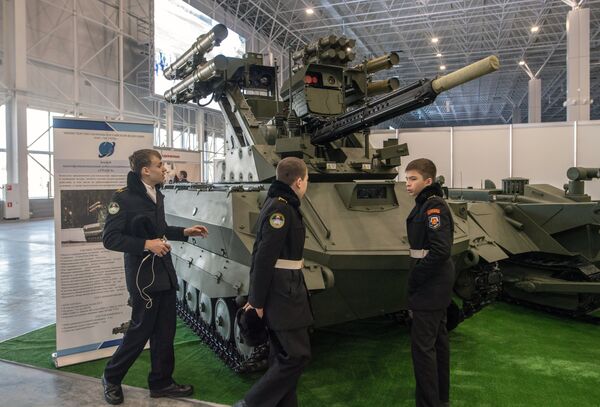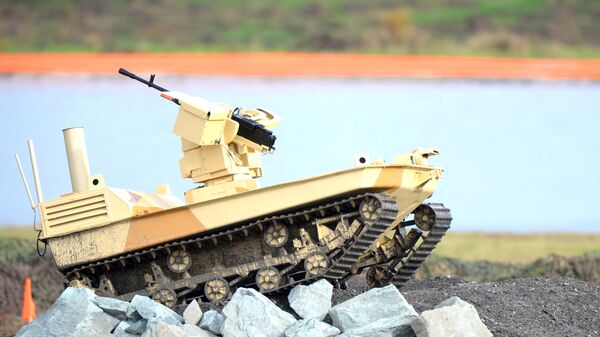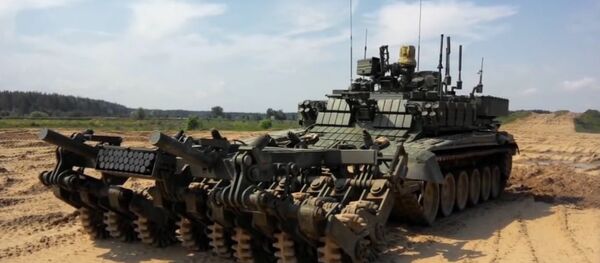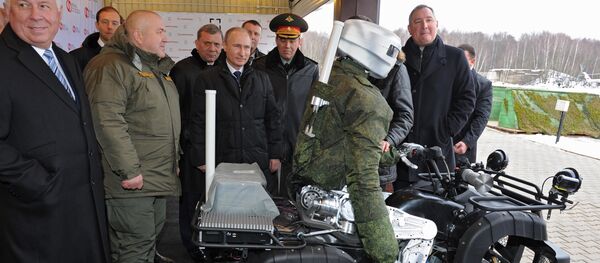Military Robots' Revolt Against People Impossible
Russian Military robots are manufactured in a way that it is up to an operator to make a final decision to hit the target, that is why robots cannot revolt against people, according to Dmitry Ostapchuk.
"The decision over target engagement is left to a person and I think it will be this way for many years to come. However, I do not believe that handing this function to a machine means opening a Pandora's box," the CEO added.
He also noted that "cases of robots' revolts when errors in software result in robots posing a threat for people are common among other countries which develop robotic systems," whereas the Uran family of military robots are equipped with a large number of safety-locks, since Russia fully understands the danger of such situations.

Military Robot Ban Initiatives Aim to Curb Russia's Technological Potential
Ostapchuk's statement comes amid various initiatives of the international community that envisages banning the research and development of military robots.
According to Dmitry Ostapchuk, these initiatives are "artificially" aimed at hindering the technological development of Russia, which is the current front-runner in this field.
A pair of Uran-9 unmanned combat vehicle photos.#Russia #Robot #weapon #Army pic.twitter.com/3yAGe226BI
— Vault 8 PRO (@vault_8) July 27, 2017
In this context the CEO pointed out a recent surge of discussions about prohibiting military robots, as earlier in November, 125 nations that are part of the UN Convention on Conventional Weapons (CCW) agreed at an annual meeting to continue talks, which started in 2014, on addressing concerns over the use of Lethal Autonomous Weapons Systems (LAWS), also referred to as killer robots, which select and engage targets without meaningful human control.
Russia Five Years Ahead of Competitors
The developer stated that Russia is in the leading position worldwide in terms of creating tactical combat robots weighing from 5 to 30 tonnes.
"According to expert estimates, two years ago, our closest competitors were estimated to be 15-17 years behind. Today they have managed to close the gap to five years, which is significant," Ostapchuk said.
At the same time, Ostapchuk stressed that the UK company has only just submitted a model of its robot tank, while the Uran-9 has been in production for the past few years.
READ MORE: Latest Creations Unveiled at Russian Military Robotics Conference
"Why do we focus on this class of robots? We are talking about the so-called class of tactical link and linear combat units, primarily at the level of the platoon, the troop. If we compare it with manned combat equipment, then our machines can be compared to the class of armored infantry vehicles, that is, the most popular type of ground weapons today," Ostapchuk explained.
The developer added that while weighing 11 tonnes, the Uran-9 robot system is compact, half the size of an infantry fighting vehicle. At the same time, it surpasses the armored vehicles of this class in terms of weapons and combat capabilities.
Russia Capable of Manufacturing Combat Robots Within Days in Case of War
Speaking about other benefits of combat robots over soldiers, Ostapchuk noted that robots were not able to feel fear, which has the potential to significantly decrease human combat readiness and functional capabilities in a combat zone.
Technologies Embedded in Russian Uran Robots Are Impossible to Copy
In answer to the question whether Ostapchuk's company had concerns that countries, purchasing Uran robots, might copy its technologies and manufacture their own robots using the software, the developer siad that "we [Russia] are not afraid of anyone seeing some widely-known microchip [in our robots], because it is not possible to extract what is uploaded onto it."
Russian armed forces during training with fire support robot BMRK "Uran-9"
— Grey-shop.ru (@Greyshopru) July 11, 2017
Read next here: https://t.co/vKUlRkrOoH#ArmyInside #Robot pic.twitter.com/KuwJnDoXy7
During the Special Operations Forces Exhibition and Conference (SOFEX) in Jordan in 2016, Valery Varlamov, the head of Russian arms exporter Rosoboronexport’s security department, said that the organization had begun internationally promoting the Uran-6 mine-clearing robot, which proved to be effective during the operation in the ancient Syrian city of Palmyra. At the same time, the company was preparing export descriptions for the robot's battle version, Uran-9, and fire-fighting version, Uran-14, Varlamov said.
READ MORE: Top 5 Military Robots in the World
A number of countries have expressed interest in purchasing 766 UPTK's products, since no other country in the world has yet created tactical robots, weighting from 5 to 30 tonnes, of this level, Ostapchuk pointed out.
United Arab Emirates #UAE interested to purchase #Russian #Uran-9 #UGV unmanned ground combat vehicle Read https://t.co/A8uUpXcB8H pic.twitter.com/9b72Ac4y5y
— Army Recognition (@ArmyRecognition) August 28, 2017
766 UPTK was established in 2013. The organization specializes in the development of robotic systems for various purposes. One of the company's most advanced developments are its Uran-series robots, which were used in the counterterrorism operation in Syria. The company is fully owned by the Russian Defense Ministry.



